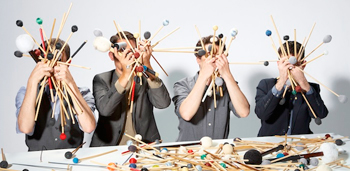by Daniel Hautzinger

Skidmore, along with Robert Dillon, Peter Martin, and Sean Connors makes up Third Coast. Many groups would be daunted by playing in an alternative space such as Transformer Station, but not Third Coast, who have performed at Chicago’s Adler Planetarium and in Frank Lloyd Wright-designed houses across the country, among other unique venues.
“We really like trying new things, playing new places, and finding cool connections that our music has with other disciplines,” Skidmore said in a phone conversation. Hence the quartet’s collaboration with engineers at the University of Notre Dame’s DeBartolo Performing Arts Center, where Third Coast is Ensemble-in-Residence. “There’s a common misconception that scientists are analytical and musicians or artists are creative. Both of those things are true. But it’s equally true that musicians are very analytical. By the same token there’s this endless creativity on the part of scientists.” By working with other disciplines, Third Coast can “find the truth that lies behind those misconceptions,” as well as hearing non-musicians’ perspectives. “It allows us to enrich our creativity and music-making and expand our horizons.”
Not that the group’s horizons are narrow, especially in terms of instruments. One piece that will be performed in Cleveland, Augusta Read Thomas’s Resounding Earth, uses over 125 different bells from around the world. New pieces often require obtaining more instruments. “Our first rehearsal is digging through boxes to find the instruments that we need and going online to research them.” Then the quartet often stops at Home Depot to search for instruments, which makes sense since their repertoire includes Music for Pieces of Wood by Steve Reich and Table Music by Thierry DuMey. (Both will be performed at Transformer Station).
The challenge doesn’t end there: “Almost every single piece of music that we play we have to re-learn how to read the music, because there is no standard way of notating a piece for 125 bells.” And finally, once they have figured out a workable setup of instruments and learned to play a piece, they have to transport all of that gear to their concerts. “We have to figure out this balance between how can we perform the music and how can we make it practical, so we can put it in a van and drive it from Chicago to Cleveland and unload that van and play a concert. It’s a fun challenge.”
Or a logistical nightmare. But the upsides of percussion far outweigh any such difficulties. “Percussion connects to more genres of music than perhaps any other instrument group. You can find it in almost every type of music that exists, from indigenous music of cultures all over the world, to global pop music, [in] electronic drum-beats, hip-hop, rock, the classical music world.” This allows Third Coast to resonate with people from many backgrounds. “We play for chamber music audiences, who I think are generally interested and pleasantly surprised by the links between our music-making and the music-making of a string quartet. And at the same time, there may be someone in the audience who’s never been to a string quartet concert, but enjoys the experience of our music. Percussion connects to so many different people and so many different traditions.”
Published on ClevelandClassical.com January 13. 2014
Click here for a printable version of this article.



